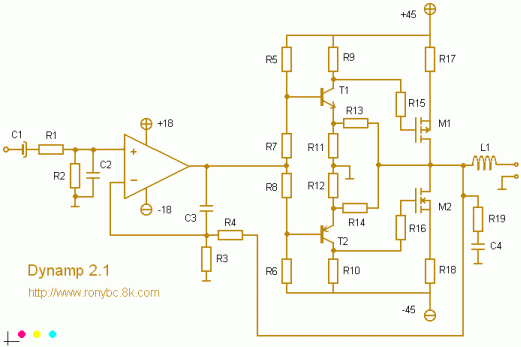Home
Fireworks
SparcZ
Win32 asm
Linkz page
Kerala
Guestbook
Misc...
About me
XXXXXXXX
3621
Opamp based MOSFET Amplifier

THD, Noise Ratio,...etc : Tolerable to most human ears.
Output Power : Dynamitic, long whistling inside my head after it is switched off.
The advantages of this amplifier are.. it is opamp based, simple and easy to build. I'm lacking an oscilloscope to tell you how contaminated the output wave is. It is a product of trial and error engineering..! No matter how Lo-Fi it may be.. the overall listening quality is pretty good. There is no point in relating the performance of this amp with its lacking circuit complexities or component counts. The idea behind this one is... the most performing simple design :)
This thing exhibited properties similar to a dynamite couple of times during the development era,
smoke'n'sound after switching on. That's why i named it The Dynamp..!
Download LTspice/SwicherCAD-III free from Linear Technology website, its a very useful piece of software. And download the LTspice model of this circuit to simulate it with LT1022 opamp.
Dynamp version 2.1 uses separate supply rails (+/-45V) to the MOSFETs. ie. The output voltage swing is not limited to opamp supply rails. LTspice simulations successfully delivered 28Vrms into 8ohm load (input: 1.6Vp-p @20kHz), that's 100 Watts, more watts can be obtained by increasing supply voltages. I didn't construct this new version of Dynamp yet. But I'm sure that it will perform very well, I have to wait until the next consumer arise...
Important: Use 100k presets for R5 and R6. Pay attention to their values whenever you change power supply voltage or applying voltages for the first time. When you do so... Set the presets to their maximum (100k) before turning on the amplifier, connect an ammeter in series to either one of the power supply rails and turn on the amp with input grounded. Adjust the presets R5 & R6 so that the quiescent current is around 40mA. Keep the values of both presets as near as possible, otherwise the network will slightly load opamp output. The procedure might be a little annoying.. but remember the moralities of this design.
Source resistors R17 & R18 are used to provide some negative feedback and thus linearize the MOSFETs. Else the behaviour of bias setting presets R5 & R6 will be too difficult to adjust, I mean the gap width between 'required quiescent current' and 'full conduction of mosfets'.
Maximum output power can be raised by increasing power supply voltage to the output stage. I saw giant 5000Watts sine waves by computer simulation..! Truly.. my heart pumped more blood by seeing it. Didn't find much joy after going beyond that... better simulate some nuclear explosions :)
Components List:
|
R1 - 2k2 R2 - 47k R3 - 1k R4 - 47k R5,R6 - 100k preset R7,R8 - 1k R9,R10 - 220ohm R11,R12 - 47ohm 1W R13,R14 - 1k 1W R15,R16 - 100ohm R17,R18 - 0.47ohm 5W R19 - 10ohm |
C1 - 47uF C2 - 220pF C3 - 220pF C4 - 100nF L1 - 3uH aircored T1 - BD139 T2 - BD140 IC1 - TL072 MOSFET1 - IRF9630 MOSFET2 - IRF630 |
Reference:
1. International Rectifiers HEXFET Application Notes.Tips:
1. Use fuses wherever they are needed..!
2. Be careful with R5 and R6, biasing network.
3. Try quality opamps like Burr-Brown OPA2134 or Analog Devices AD823
4. Minimize lead and track lengths of decoupling caps to reduce noise.
5. Use polyester caps in parallel to electrolytic coupling caps.
6. Always use thick wire for power and speaker lines.
7. Do not operate this amp near seismographic monitoring stations.
8. Please help the author by droping a small donation
Copyright ® 2004 ronybc Hi-Fi design laboratory.